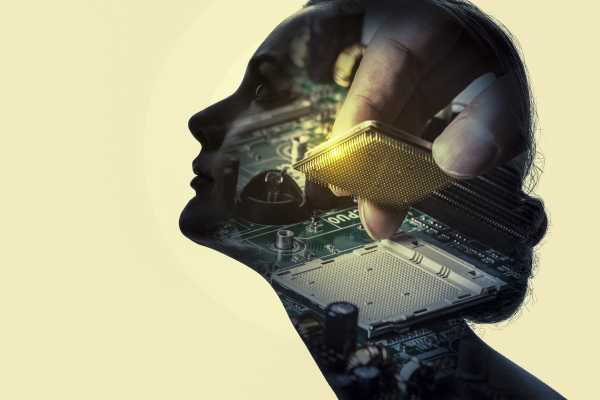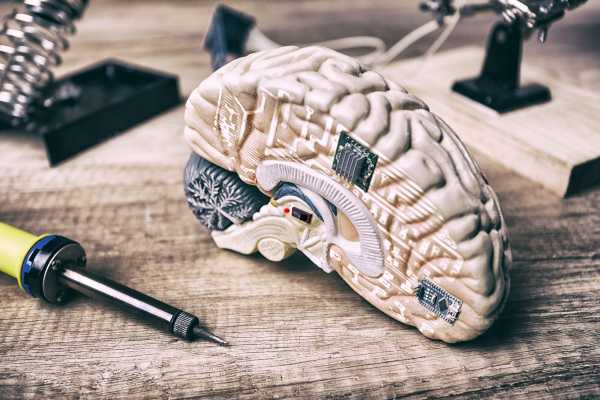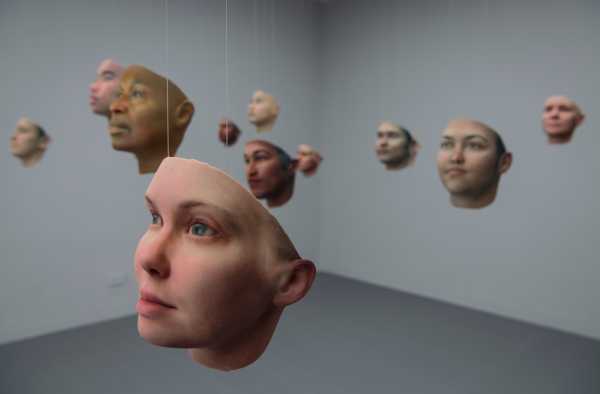 — and human nature” alt=”How biohackers are trying to upgrade their brains, their bodies — and human nature” />
— and human nature” alt=”How biohackers are trying to upgrade their brains, their bodies — and human nature” />
How biohackers are trying to upgrade their brains, their bodies — and human nature
9 questions about biohacking you were too embarrassed to ask.
By
Sigal Samuel
Jun 25, 2019, 8:00am EDT
Share
Tweet
Share
Share
How biohackers are trying to upgrade their brains, their bodies — and human nature
tweet
share
This story is part of a group of stories called

Finding the best ways to do good. Made possible by The Rockefeller Foundation.
Even if you haven’t heard the term “biohacking” before, you’ve probably encountered some version of it. Maybe you’ve seen Twitter CEO Jack Dorsey extolling the benefits of fasting intermittently and drinking “salt juice” each morning. Maybe you’ve read about former NASA employee Josiah Zayner injecting himself with DNA using the gene-editing technology CRISPR.
Maybe you, like me, have a colleague who’s had a chip implanted in their hand.
These are all types of biohacking, a broad term for a lifestyle that’s growing increasingly popular, and not just in Silicon Valley, where it really took off.
Biohacking — also known as DIY biology — is an extremely broad and amorphous term that can cover a huge range of activities, from performing science experiments on yeast or other organisms to tracking your own sleep and diet to changing your own biology by pumping a younger person’s blood into your veins in the hope that it’ll fight aging. (Yes, that is a real thing, and it’s called a young blood transfusion. More on that later.)
The type of biohackers currently gaining the most notoriety are the ones who experiment — outside of traditional lab spaces and institutions — on their own bodies with the hope of boosting their physical and cognitive performance. They form one branch of transhumanism, a movement that holds that human beings can and should use technology to augment and evolve our species.
Some biohackers have science PhDs; others are complete amateurs. And their ways of trying to “hack” biology are as diverse as they are. It can be tricky to understand the different types of hacks, what differentiates them from traditional medicine, and how safe — or legal — they are.
As biohacking starts to appear more often in headlines, it’s worth getting clear on some of the fundamentals. Here are nine questions that can help you make sense of biohacking.
1) First of all, what exactly is biohacking? What are some common examples of it?
Depending on whom you ask, you’ll get a different definition of biohacking. Since it can encompass a dizzying range of pursuits, I’m mostly going to look at biohacking defined as the attempt to manipulate your brain and body in order to optimize performance, outside the realm of traditional medicine. But later on, I’ll also give an overview of some other types of biohacking (including some that can lead to pretty unbelievable art).
Dave Asprey, a biohacker who created the supplement company Bulletproof, told me that for him, biohacking is “the art and science of changing the environment around you and inside you so that you have full control over your own biology.” He’s very game to experiment on his body: He has stem cells injected into his joints, takes dozens of supplements daily, bathes in infrared light, and much more. It’s all part of his quest to live until at least age 180.
One word Asprey likes to use a lot is “control,” and that kind of language is typical of many biohackers, who often talk about “optimizing” and “upgrading” their minds and bodies.
Some of their techniques for achieving that are things people have been doing for centuries, like Vipassana meditation and intermittent fasting. Both of those are part of Dorsey’s routine, which he detailed in a podcast interview. He tries to do two hours of meditation a day and eats only one meal (dinner) on weekdays; on weekends, he doesn’t eat at all. (Critics worry that his dietary habits sound a bit like an eating disorder, or that they might unintentionally influence others to develop a disorder.) He also kicks off each morning with an ice bath before walking the 5 miles to Twitter HQ.
Supplements are another popular tool in the biohacker’s arsenal. There’s a whole host of pills people take, from anti-aging supplements to nootropics or “smart drugs.”
Since biohackers are often interested in quantifying every aspect of themselves, they may buy wearable devices to, say, track their sleep patterns. (For that purpose, Dorsey swears by the Oura Ring.) The more data you have on your body’s mechanical functions, the more you can optimize the machine that is you — or so the thinking goes.
Then there are some of the more radical practices: cryotherapy (purposely making yourself cold), neurofeedback (training yourself to regulate your brain waves), near-infrared saunas (they supposedly help you escape stress from electromagnetic transmissions), and virtual float tanks (which are meant to induce a meditative state through sensory deprivation), among others. Some people spend hundreds of thousands of dollars on these treatments.
A subset of biohackers called grinders go so far as to implant devices like computer chips in their bodies. The implants allow them to do everything from opening doors without a fob to monitoring their glucose levels subcutaneously.
For some grinders, like Zoltan Istvan, who ran for president as head of the Transhumanist Party, having an implant is fun and convenient: “I’ve grown to relish and rely on the technology,” he recently wrote in the New York Times. “The electric lock on the front door of my house has a chip scanner, and it’s nice to go surfing and jogging without having to carry keys around.”
Istvan also noted that “for some people without functioning arms, chips in their feet are the simplest way to open doors or operate some household items modified with chip readers.” Other grinders are deeply curious about blurring the line between human and machine, and they get a thrill out of seeing all the ways we can augment our flesh-and-blood bodies using tech. Implants, for them, are a starter experiment.
2) Why are people doing this? What drives someone to biohack themselves?
On a really basic level, biohacking comes down to something we can all relate to: the desire to feel better — and to see just how far we can push the human body. That desire comes in a range of flavors, though. Some people just want to not be sick anymore. Others want to become as smart and strong as they possibly can. An even more ambitious crowd wants to be as smart and strong as possible for as long as possible — in other words, they want to radically extend their life span.
These goals have a way of escalating. Once you’ve determined (or think you’ve determined) that there are concrete “hacks” you can use by yourself right now to go from sick to healthy, or healthy to enhanced, you start to think: Well, why stop there? Why not shoot for peak performance? Why not try to live forever? What starts as a simple wish to be free from pain can snowball into self-improvement on steroids.
That was the case for Asprey. Now in his 40s, he got into biohacking because he was unwell. Before hitting age 30, he was diagnosed with high risk of stroke and heart attack, suffered from cognitive dysfunction, and weighed 300 pounds. “I just wanted to control my own biology because I was tired of being in pain and having mood swings,” he told me.
Now that he feels healthier, he wants to slow the normal aging process and optimize every part of his biology. “I don’t want to be just healthy; that’s average. I want to perform; that’s daring to be above average. Instead of ‘How do I achieve health?’ it’s ‘How do I kick more ass?’”
Zayner, the biohacker who once injected himself with CRISPR DNA, has also had health problems for years, and some of his biohacking pursuits have been explicit attempts to cure himself. But he’s also motivated in large part by frustration. Like some other biohackers with an anti-establishment streak, he’s irritated by federal officials’ purported sluggishness in greenlighting all sorts of medical treatments. In the US, it can take 10 years for a new drug to be developed and approved; for people with serious health conditions, that wait time can feel cruelly long. Zayner claims that’s part of why he wants to democratize science and empower people to experiment on themselves.
(However, he admits that some of his stunts have been purposely provocative and that “I do ridiculous stuff also. I’m sure my motives are not 100 percent pure all the time.”)

The biohacking community also offers just that: community. It gives people a chance to explore unconventional ideas in a non-hierarchical setting, and to refashion the feeling of being outside the norm into a cool identity. Biohackers congregate in dedicated online networks, in Slack and WhatsApp groups — WeFast, for example, is for intermittent fasters. In person, they run experiments and take classes at “hacklabs,” improvised laboratories that are open to the public, and attend any one of the dozens of biohacking conferences put on each year.
3) How different is biohacking from traditional medicine? What makes something “count” as a biohacking pursuit?
Certain kinds of biohacking go far beyond traditional medicine, while other kinds bleed into it.
Plenty of age-old techniques — meditation, fasting — can be considered a basic type of biohacking. So can going to a spin class or taking antidepressants.
What differentiates biohacking is arguably not that it’s a different genre of activity but that the activities are undertaken with a particular mindset. The underlying philosophy is that we don’t need to accept our bodies’ shortcomings — we can engineer our way past them using a range of high- and low-tech solutions. And we don’t necessarily need to wait for a double-blind, randomized, placebo-controlled trial, traditional medicine’s gold standard. We can start to transform our lives right now.
As millionaire Serge Faguet, who plans to live forever, put it: “People here [in Silicon Valley] have a technical mindset, so they think of everything as an engineering problem. A lot of people who are not of a technical mindset assume that, ‘Hey, people have always been dying,’ but I think there’s going to be a greater level of awareness [of biohacking] once results start to happen.”
Rob Carlson, an expert on synthetic biology who’s been advocating for biohacking since the early 2000s, told me that to his mind, “all of modern medicine is hacking,” but that people often call certain folks “hackers” as a way of delegitimizing them. “It’s a way of categorizing the other — like, ‘Those biohackers over there do that weird thing.’ This is actually a bigger societal question: Who’s qualified to do anything? And why do you not permit some people to explore new things and talk about that in public spheres?”
If it’s taken to extremes, the “Who’s qualified to do anything?” mindset can delegitimize scientific expertise in a way that can endanger public health. Luckily, biohackers don’t generally seem interested in dethroning expertise to that dangerous degree; many just don’t think they should be locked out of scientific discovery because they lack conventional credentials like a PhD.
4) So how much of this is backed by scientific research?
Some biohacks are backed by strong scientific evidence and are likely to be beneficial. Often, these are the ones that are tried and true, debugged over centuries of experimentation. For example, clinical trials have shown that mindfulness meditation can help reduce anxiety and chronic pain.
But other hacks, based on weak or incomplete evidence, could be either ineffective or actually harmful.
After Dorsey endorsed a particular near-infrared sauna sold by SaunaSpace, which claims its product boosts cellular regeneration and fights aging by detoxing your body, the company experienced a surge in demand. But according to the New York Times, “though a study of middle-aged and older Finnish men indicates that their health benefited from saunas, there have been no major studies conducted of” this type of sauna, which directs incandescent light at your body. So is buying this expensive product likely to improve your health? We can’t say that yet.
Similarly, the intermittent fasting that Dorsey endorses may yield health benefits for some, but scientists still have plenty of questions about it. Although there’s a lot of research on the long-term health outcomes of fasting in animals — and much of it is promising — the research literature on humans is much thinner. Fasting has gone mainstream, but because it’s done so ahead of the science, it falls into the “proceed with caution” category. Critics have noted that for those who’ve struggled with eating disorders, it could be dangerous.
And while we’re on the topic of biohacking nutrition: My colleague Julia Belluz has previously reported on the Bulletproof Diet promoted by Asprey, who she says “vilifies healthy foods and suggests part of the way to achieve a ‘pound a day’ weight loss is to buy his expensive, ‘science-based’ Bulletproof products.” She was not convinced by the citations for his claims:
5) This all sounds like it can be taken to extremes. What are the most dangerous types of biohacking being tried?
Some of the highest-risk hacks are being undertaken by people who feel desperate. On some level, that’s very understandable. If you’re sick and in constant pain, or if you’re old and scared to die, and traditional medicine has nothing that works to quell your suffering, who can fault you for seeking a solution elsewhere?
Yet some of the solutions being tried these days are so dangerous, they’re just not worth the risk.
If you’ve watched HBO’s Silicon Valley, then you’re already familiar with young blood transfusions. As a refresher, that’s when an older person pays for a young person’s blood and has it pumped into their veins in the hope that it’ll fight aging.
This putative treatment sounds vampiric, yet it’s gained popularity in the Silicon Valley area, where people have actually paid $8,000 a pop to participate in trials. The billionaire tech investor Peter Thiel has expressed keen interest.
As Chavie Lieber noted for Vox, although some limited studies suggest that these transfusions might fend off diseases like Alzheimer’s, Parkinson’s, heart disease, and multiple sclerosis, these claims haven’t been proven.
In February, the Food and Drug Administration released a statement warning consumers away from the transfusions: “Simply put, we’re concerned that some patients are being preyed upon by unscrupulous actors touting treatments of plasma from young donors as cures and remedies. Such treatments have no proven clinical benefits for the uses for which these clinics are advertising them and are potentially harmful.”
Another biohack that definitely falls in the “don’t try this at home” category: fecal transplants, or transferring stool from a healthy donor into the gastrointestinal tract of an unhealthy recipient. In 2016, sick of suffering from severe stomach pain, Zayner decided to give himself a fecal transplant in a hotel room. He had procured a friend’s poop and planned to inoculate himself using the microbes in it. Ever the public stuntman, he invited a journalist to document the procedure. Afterward, he claimed the experiment left him feeling better.
But fecal transplants are still experimental and not approved by the FDA. The FDA recently reported that two people had contracted serious infections from fecal transplants that contained drug-resistant bacteria. One of the people died. And this was in the context of a clinical trial — presumably, a DIY attempt could be even riskier. The FDA is putting a stop to clinical trials on the transplants for now.
Zayner also popularized the notion that you can edit your own DNA with CRISPR. In 2017, he injected himself with CRISPR DNA at a biotech conference, live-streaming the experiment. He later said he regretted that stunt because it could lead others to copy him and “people are going to get hurt.” Yet when asked whether his company, the Odin, which he runs out of his garage in Oakland, California, was going to stop selling CRISPR kits to the general public, he said no.
Ellen Jorgensen, a molecular biologist who co-founded Genspace and Biotech Without Borders, two Brooklyn-based biology labs open to the public, finds antics like Zayner’s worrisome. A self-identified biohacker, she told me people shouldn’t buy Zayner’s kits, not just because they don’t work half the time (she’s a professional and even she couldn’t get it to work), but because CRISPR is such a new technology that scientists aren’t yet sure of all the risks involved in using it. By tinkering with your genome, you could unintentionally cause a mutation that increases your risk of developing cancer, she said. It’s a dangerous practice that should not be marketed as a DIY activity.
“At Genspace and Biotech Without Borders, we always get the most heartbreaking emails from parents of children afflicted with genetic diseases,” Jorgensen says. “They have watched these Josiah Zayner videos and they want to come into our class and cure their kids. We have to tell them, ‘This is a fantasy.’ … That is incredibly painful.”
She thinks such biohacking stunts give biohackers like her a bad name. “It’s bad for the DIY bio community,” she said, “because it makes people feel that as a general rule we’re irresponsible.”
6) Are all these biohacking pursuits legal?
Existing regulations weren’t built to make sense of something like biohacking, which in some cases stretches the very limits of what it means to be a human being. That means that a lot of biohacking pursuits exist in a legal gray zone: frowned upon by bodies like the FDA, but not yet outright illegal, or not enforced as such. As biohackers traverse uncharted territory, regulators are scrambling to catch up with them.
After the FDA released its statement in February urging people to stay away from young blood transfusions, the San Francisco-based startup Ambrosia, which was well known for offering the transfusions, said on its website that it had “ceased patient treatments.” The site now says, “We are currently in discussion with the FDA on the topic of young plasma.”
This wasn’t the FDA’s first foray into biohacking. In 2016, the agency objected to Zayner selling kits to brew glow-in-the-dark beer. And after he injected himself with CRISPR, the FDA released a notice saying the sale of DIY gene-editing kits for use on humans is illegal. Zayner disregarded the warning and continued to sell his wares.
Now he’s under investigation by California’s Department of Consumer Affairs, accused of practicing medicine without a license.
The biohackers I spoke to said restrictive regulation would be a counterproductive response to biohacking because it’ll just drive the practice underground. They say it’s better to encourage a culture of transparency so that people can ask questions about how to do something safely, without fear of reprisal.
According to Jorgensen, most biohackers are safety-conscious, not the sorts of people interested in engineering a pandemic. They’ve even generated and adopted their own codes of ethics. She herself has had a working relationship with law enforcement since the early 2000s.
“At the beginning of the DIY bio movement, we did an awful lot of work with Homeland Security,” she said. “And as far back as 2009, the FBI was reaching out to the DIY community to try to build bridges.”
Carlson told me he’s noticed two general shifts over the past 20 years. “One was after 2001, after the anthrax attacks, when Washington, DC, lost their damn minds and just went into a reactive mode and tried to shut everything down,” he said. “As of 2004 or 2005, the FBI was arresting people for doing biology in their homes.”
Then in 2009, the National Security Council dramatically changed perspectives. It published the National Strategy for Countering Biological Threats, which embraced “innovation and open access to the insights and materials needed to advance individual initiatives,” including in “private laboratories in basements and garages.”
Now, though, some agencies seem to think they ought to take action. But even if there were clear regulations governing all biohacking activities, there would be no straightforward way to stop people from pursuing them behind closed doors. “This technology is available and implementable anywhere, there’s no physical means to control access to it, so what would regulating that mean?” Carlson said.
7) One of the more ambitious types of biohacking is life extension, the attempt to live longer or even cheat death entirely. What are the physical limits of life extension?
Some biohackers believe that by leveraging technology, they’ll be able to live longer but stay younger. Gerontologist Aubrey de Grey claims people will be able to live to age 1,000. In fact, he says the first person who will live to 1,000 has already been born.
De Grey focuses on developing strategies for repairing seven types of cellular and molecular damage associated with aging — or, as he calls them, “Strategies for Engineered Negligible Senescence.” His nonprofit, the Methuselah Foundation, has attracted huge investments, including more than $6 million from Thiel. Its aim is to “make 90 the new 50 by 2030.”
Wondering whether de Grey’s goals are realistic, I reached out to Genspace co-founder Oliver Medvedik, who earned his PhD at Harvard Medical School and now directs the Kanbar Center for Biomedical Engineering at Cooper Union. “Living to 1,000? It’s definitely within our realm of possibility if we as a society that doles out money [to fund research we deem worthy] decide we want to do it,” he told me.
He’s optimistic, he said, because the scientific community is finally converging on a consensus about what the root causes of aging are (damage to mitochondria and epigenetic changes are a couple of examples). And in the past five years, he’s seen an explosion of promising papers on possible ways to address those causes.
Researchers who want to fight aging generally adopt two different approaches. The first is the “small molecule” approach, which often focuses on dietary supplements. Medvedik calls that the “low-hanging fruit.” He spoke excitedly about the possibility of creating a supplement from a plant compound called fisetin, noting that a recent (small) Mayo Clinic trial suggests high concentrations of fisetin can clear out senescent cells in humans — cells that have stopped dividing and that contribute to aging.
The other approach is more dramatic: genetic engineering. Scientists taking this tack in mouse studies usually tinker with a genome in embryo, meaning that new mice are born with the fix already in place. Medvedik pointed out that’s not very useful for treating humans — we want to be able to treat people who have already been born and have begun to age.
But he sees promise here too. He cited a new study that used CRISPR to target Hutchinson-Gilford progeria syndrome, a genetic disorder that manifests as accelerated aging, in a mouse model. “It wasn’t a total cure — they extended the life span of these mice by maybe 30 percent — but what I was very interested in is the fact that it was delivered into mice that had already been born.”
He’s also intrigued by potential non-pharmaceutical treatments for aging-related diseases like Alzheimer’s — for example, the use of light stimulation to influence brain waves — but those probably won’t help us out anytime soon, for a simple reason: “It’s not a drug. You can’t package and sell it,” he said. “Pharma can’t monetize it.”
Like many in the biohacking community, Medvedik sounded a note of frustration about how the medical system holds back anti-aging progress. “If you were to come up with a compound right now that literally cures aging, you couldn’t get it approved,” he said. “By the definition we’ve set up, aging isn’t a disease, and if you want to get it approved by the FDA you have to target a certain disease. That just seems very strange and antiquated and broken.”
8) Biohackers also include people who engage in DIY science without experimenting on themselves. What’s that form of biohacking like?
Not everyone who’s interested in biohacking is interested in self-experimentation. Some come to it because they care about bringing science to the masses, alleviating the climate crisis, or making art that shakes us out of our comfort zones.
“My version of biohacking is unexpected people in unexpected places doing biotechnology,” Jorgensen told me. For her, the emphasis is on democratizing cutting-edge science while keeping it safe. The community labs she’s helped to build, Genspace and Biotech Without Borders, offer classes on using CRISPR technology to edit a genome — but participants work on the genome of yeast, never on their own bodies.
Some people in the community are altruistically motivated. They want to use biohacking to save the environment by figuring out a way to make a recyclable plastic or a biofuel. They might experiment on organisms in makeshift labs in their garages. Or they might take a Genspace class on how to make furniture out of fungi or paper out of kombucha.
Experimental artists have also taken an interest in biohacking. For them, biology is just another palette. The artists Oron Catts and Ionat Zurr from the University of Western Australia were actually the first people to create and serve up lab-grown meat. They took some starter cells from a frog and used them to grow small “steaks” of frog meat, which they fed to gallery-goers in France at a 2003 art installation called “Disembodied Cuisine.”

More recently, Alexandra Daisy Ginsberg has used old floral DNA to recreate the smell of flowers driven to extinction by humans, enabling us to catch a whiff of them once more.
And this summer, a London museum is displaying something rather less fragrant: cheese made from celebrities. Yes, you read that right: The cheese was created with bacteria harvested from the armpits, toes, bellybuttons, and nostrils of famous people. If you’re thoroughly grossed out by this, don’t worry: The food won’t actually be eaten — this “bioart” project is meant more as a thought experiment than as dinner.
9) At its most extreme, biohacking can fundamentally alter human nature. Should we be worried?
When you hear about people genetically engineering themselves or trying young blood transfusions in an effort to ward off death, it’s easy to feel a sense of vertigo about what we’re coming to as a species.
But the fact is we’ve been altering human nature since the very beginning. Inventing agriculture, for example, helped us transform ourselves from nomadic hunter-gatherers into sedentary civilizations. And whether we think of it this way or not, we’re all already doing some kind of biohacking every day.
The deeper I delve into biohacking, the more I think a lot of the discomfort with it boils down to simple neophobia — a fear of what’s new. (Not all of the discomfort, mind you: The more extreme hacks really are dangerous.)
As one of my colleagues put it to me, 40 years ago, “test tube babies” seemed unnatural, a freak-show curiosity; now in vitro fertilization has achieved mainstream acceptance. Will biohacking undergo the same progression? Or is it really altering human nature in a more fundamental way, a way that should concern us?
When I asked Carlson, he refused to buy the premise of the question.
“If you assert that hackers are changing what it means to be human, then we need to first have an agreement about what it means to be human,” he said. “And I’m not going to buy into the idea that there is one thing that is being human. Across the sweep of history, it’s odd to say humans are static — it’s not the case that humans in 1500 were the same as they are today.”
That’s true. Nowadays, we live longer. We’re taller. We’re more mobile. And we marry and have kids with people who come from different continents, different cultures — a profound departure from old customs that has nothing to do with genetic engineering but that’s nonetheless resulting in genetic change.
Still, biohackers are talking about making such significant changes that the risks they carry are significant too. What if biohackers’ “upgrades” don’t get distributed evenly across the human population? What if, for example, the cure for aging becomes available, but only to the rich? Will that lead to an even wider life expectancy gap, where rich people live longer and poor people die younger?
Medvedik dismissed that concern, arguing that a lot of interventions that could lengthen our lives, like supplements, wouldn’t be expensive to produce. “There’s no reason why that stuff can’t be dirt-cheap. But that depends on what we do as a society,” he said. Insulin doesn’t cost much to produce, but as a society we’ve allowed companies to jack up the price so high that many people with diabetes are now skipping lifesaving doses. That’s horrifying, but it’s not a function of the technology itself.
Here’s another risk associated with biohacking, one I think is even more serious: By making ourselves smarter and stronger and potentially even immortal (a difference of kind, not just of degree), we may create a society in which everyone feels pressure to alter their biology — even if they don’t want to. To refuse a hack would mean to be at a huge professional disadvantage, or to face moral condemnation for remaining suboptimal when optimization is possible. In a world of superhumans, it may become increasingly hard to stay “merely” human.
“The flip side of all this is the ‘perfect race’ or eugenics specter,” Jorgensen acknowledged. “This is a powerful set of technologies that can be used in different ways. We’d better think about it and use it wisely.”
Sign up for the Future Perfect newsletter. Twice a week, you’ll get a roundup of ideas and solutions for tackling our biggest challenges: improving public health, decreasing human and animal suffering, easing catastrophic risks, and — to put it simply — getting better at doing good.
Sourse: vox.com






